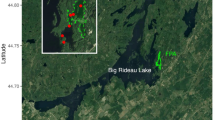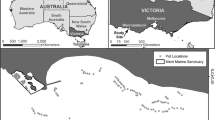Abstract
The taillight shiner, Notropis maculatus (Hay in Proc United States Natl Museum 3:488-515, 1881), primarily occurs in the southeastern United States, with rare occurrences in Illinois, where it is state listed as endangered. The first observation in Illinois was in 1987 and the species was last seen in the state in 1988. However, the taillight shiner was recently rediscovered in Buttonland Swamp within the Cache River watershed in September 2020 during fish community surveys. A total of 311 taillight shiners were captured from September 2020 to October 2022 within Buttonland Swamp using electrofishing, mini fyke nets, and light traps from the fish community surveys. Habitat associations were assessed using repeated measures mixed models and a conditional inference tree was developed to assess the probability of taillight shiner occurrence in electrofishing samples based on habitat variables and dissolved oxygen. We also assessed differences in taillight shiner length among years and seasons. Emergent vegetation was particularly important in predicting the occurrence of taillight shiners in samples, with dissolved oxygen and silt/clay also being important. Taillight shiner length distributions were similar among years and significantly different among seasons. Spawning occurred in spring, while post-spawn mortality occurred between June and August. This study provides important information regarding habitat associations, probability of occurrence in samples, recruitment, and timing of post-spawn mortality of taillight shiners in Illinois, which could inform future sampling efforts in Illinois and adjacent states. This rediscovery indicates that the taillight shiner is still present in Illinois and further search efforts to assess the species’ status in Illinois are needed.





Similar content being viewed by others
Data availability
The data that support the findings of this study are available from the corresponding author upon request.
References
Beach ML (1974) Food habits and reproduction of the taillight shiner, Notropis maculatus (Hay), in central Florida. Fla Sci 37:5–16
Bennett D, Middleton B, Kraft S, Lant C, Sengupta R, Beaulieu J, Sharpe D, Cook K, Burr B, Beck R, Flanagan K (2001) Ecosystem function and restoration in the Cache River Bioreserve. Southern Illinois University Carbondale, Illinois
Bice CM, Gehrig SL, Zampatti BP, Nicol JM, Wilson P, Leigh SL, Marsland K (2014) Flow-induced alterations to fish assemblages, habitat and fish–habitat associations in a regulated lowland river. Hydrobiologia 722(1):205–222
Bouska K, Erndt-Pitcher K, Lloyd A, Nelson A, Stoebner T (2012) Challenges to integrating human and natural systems: an assessment of the Cache River watershed. Reports. Paper 1. http://opensiuc.lib.siu.edu/igert_reports/1. Accessed 13 November 2022
Burnham KP, Anderson DR (2002) Model selection and multimodel inference: a practical information-theoretic approach, 2nd edn. Springer-Verlag, New York
Burr BM (1992) The fishes of Illinois: an overview of a dynamic fauna. In: Page LM, Jeffords MR (eds) Illinois Natural History Survey Bulletin 427(34):417
Burr BM, Page LM (1975) Distribution and life history notes on the taillight shiner Notropis maculatus in Kentucky. Trans Ky Acad Sci 36:71–74
Burr BM, Warren ML Jr, Cummings KS (1988) New distributional records of Illinois fishes with additions to the known fauna. Trans Ill Acad Sci 81:163–170
Carassou L, Ponton D (2007) Spatio-temporal structure of pelagic larval and juvenile fish assemblages in coastal areas of New Caledonia, southwest Pacific. Mar Biol 150(4):697–711
Chapman JM, Proulx CL, Veilleux MA, Levert C, Bliss S, Andre ME, Lapointe NW, Cooke SJ (2014) Clear as mud: a meta-analysis on the effects of sedimentation on freshwater fish and the effectiveness of sediment-control measures. Water Res 56:190–202
Cowell BC, Barnett BS (1974) Life history of the taillight shiner, Notropis maculatus, in Central Florida. Am Midl Nat 91(2):282–293. https://doi.org/10.2307/2424323
Czúcz B, Gálhidy L, Mátyás C (2011) Present and forecasted xeric climatic limits of beech and sessile oak distribution at low altitudes in Central Europe. Ann For Sci 68:99–108
Demissie M, Bekele E, Lian Y, Keefer L (2010) Hydrologic and hydraulic modeling for evaluating alternatives for managed connection of the Upper and Lower Cache Rivers. Illinois State Water Survey Contract Report 2010-06. University of Illinois. https://www.ideals.illinois.edu/items/18767. Accessed 15 November 2022
Demissie M, Soong TW, Allgire R, Keefer L, Makowski P (1990) Cache River basin: hydrology, hydraulics, and sediment transport. Volume 1: background, data collection, and analysis. Illinois State Water Survey, Report 484. https://www.ideals.illinois.edu/items/76074. Accessed 2 November 2022
Edgar J, Manning B (1997) The Cache River basin an inventory of the region’s resources. https://dnr.illinois.gov/content/dam/soi/en/web/dnr/publications/documents/00000415.pdf. Accessed 10 November 2022
ESRI (2016) ArcGIS Desktop 10.5. Environmental Systems Research Institute
Goslee S, Urban D (2022) Package ‘ecodist’. https://cran.r-project.org/web/packages/ecodist/ecodist.pdf. Accessed 18 October 2023
Gough SC (2005) Historic and prehistoric hydrology of the Cache River, Illinois. In: Unpublished report to the Cache River Joint Venture Partnership (JVP). Little River Research & Design, Illinois
Gurevitch J, Chester ST (1986) Analysis of repeated measures experiments. Ecology 67:251–255
Harvey BC (1987) Susceptibility of young-of-the-year fishes to downstream displacement by flooding. Trans Am Fish Soc 116(6):851–855
Hay OP (1881) On a collection of fishes from eastern Mississippi. Proc United States Natl Museum 3:488–515
Holmquist HM (2022) Use of assemblage structure, abundance, and year-class strength to assess fish assemblage responses to water level fluctuations. MS thesis, Southern Illinois University, Carbondale
Hothorn T, Hornik K, Strobl C, Zeileis A (2023) Package ‘party’. http://party.R-forge.R-project.org. Accessed 18 October 2023
Hothorn T, Hornik K, Zeileis A (2006) Unbiased recursive partitioning: a conditional inference framework. J Comput Graph Stat 15:651–674
Hothorn T, Zeileis A (2015) Partykit: a toolkit for recursive partytioning. J Mach Learn Res 16:3905–3909
Illinois Department of Natural Resources (2020) Illinois endangered and threatened species list. Checklist of Illinois endangered and threatened animals and plants. https://dnr.illinois.gov/content/dam/soi/en/web/dnr/espb/documents/et-list-review-and-revision/illinoisendangeredandthreatenedspecies.pdf. Accessed 21 February 2023
Johnstone CP, Lill A, Reina RD (2014) Habitat loss, fragmentation and degradation effects on small mammals: analysis with conditional inference tree statistical modelling. Biol Conserv 176:80–98
Jonsson M, Wardle DA (2009) The influence of freshwater-lake subsidies on invertebrates occupying terrestrial vegetation. Acta Oecol 35(5):698–704
Kemp P, Sear D, Collins A, Naden P, Jones I (2011) The impacts of fine sediment on riverine fish. Hydrol Process 25(11):1800–1821
Kjelland ME, Woodley CM, Swannack TM, Smith DL (2015) A review of the potential effects of suspended sediment on fishes: potential dredging-related physiological, behavioral, and transgenerational implications. Environ Syst Decis 35:334–350
Matthews WJ, Marsh-Matthews E (2003) Effects of drought on fish across axes of space, time and ecological complexity. Freshw Biol 48(7):1232–1253
Metzke BA, Burr BM, Hinz LC Jr, Page LM, Taylor CA (2022) An atlas of Illinois fishes: 150 years of change. University of Illinois Press, Illinois
Metzke BA, Hinz LC Jr, Hulin AC (2012) Status revision and update for Illinois’ fish species in greatest need of conservation. Ill Nat Hist Sur Tech Rep 2012(19):1–179
Michaletz PH (1997) Factors affecting abundance, growth, and survival of age-0 gizzard shad. Trans Am Fish Soc 126(1):84–100
Missouri Department of Conservation (n.d.) Taillight shiner. https://mdc.mo.gov/discover-nature/field-guide/taillight-shiner. Accessed 20 February 2023
Page LM, Burr BM (2011) Taillight shiner. In: Peterson field guide to freshwater fishes of North America, North of Mexico, 2nd edn. Houghton Mifflin, New York, p 293
Page LM, Retzer ME (2002) The status of Illinois’ rarest fishes and crustaceans. Trans Ill State Acad Sci 95(4):311–326
Pflieger WL (1997) The fishes of Missouri. The Conservation Commission of the State of Missouri, Missouri, pp 148–149
R Core Team (2022) R: a language and environment for statistical computing. R Foundation for Statistical Computing, Vienna, Austria. https://www.R-project.org/
Ramsar Convention (2009) The Ramsar convention on wetlands. http://www.ramsar.org. Accessed 20 February 2023
Robison HW (1978) Distribution and habitat of the taillight shiner, Notropis maculatus (Hay), in Arkansas. J Ark Acad Sci 32(1):68–70
Robison HW, Buchanan TM (2019) Fishes of Arkansas. The University of Arkansas Press, Fayetteville
Sakamoto Y, Ishiguro M, Kitagawa G (1986) Akaike information criterion statistics. KTK Scientific Publishers, Japan
Searle SR, Speed FM, Milliken GA (1980) Population marginal means in the linear model: an alternative to least squares means. Am Stat 34:216–221
Vandermyde JM, Shults S (2015) Survey of historic populations of slackwater fish species in greatest need of conservation in the Cache River watershed. Illinois Nat History Survey Techn Rep 2015(44):1–38
Wells WG (2010) An evaluation of the fishes of Obion Creek with the Kentucky index of biotic integrity. J Ky Acad Sci 71(1):26–35
Acknowledgements
This research would not be possible without K. Bowe, F. Whalen, and G. McGoldrick who assisted in the field, and J. Hirst and B. Burr who provided guidance identifying fish. Funding for this study was provided by the Illinois Department of Natural Resources (IDNR) through the State Wildlife Grants program (project T-130-R-1) in cooperation with the U.S. Fish and Wildlife Service, Wildlife and Sport Fish Restoration Program. We also thank IDNR and Cypress Creek National Wildlife Refuge for granting access to their property.
Funding
This study was funded by the Illinois Department of Natural Resources and the U.S. Fish and Wildlife Service under project T-130.
Author information
Authors and Affiliations
Contributions
Conceived and designed the investigation: HH, AM. Performed field and/or laboratory work: HH, AM. Analyzed the data: HH, AM. Contributed materials, reagents, and/or analysis tools: HH, AM, GW, BM. Wrote the paper: HH, AM, GW, BM. Acquired funding: GW. All authors contributed edits and comments toward the final manuscript.
Corresponding author
Ethics declarations
Ethics approval
This project was conducted in compliance with Animal Welfare Act Regulations, the Public Health Service Policy on Humane Care and Use of Laboratory Animals, the Ag Guide, and the NIH Guide for the Care and Use of Laboratory Animals. The research protocol was approved by the Animal Study Protocol (Protocol No. 19-035). Handling of specimen were approved by Illinois Department of Natural Resources and was in accordance with their Endangered and Threatened Species Permit guidelines (Permit No. 14360 and NH22.6362). The Illinois Nature Preserves Commission approved this research protocol, which was also in compliance with the Illinois Natural Areas Preservation Act (525 ILCS 30), Rules for Management of Illinois Nature Preserves (17 Ill. Admin. Code 4000), and Regulation of Public Use of Illinois Dedicated Nature Preserves (17 Ill. Admin. Code 4015).
Competing interests
The authors declare no competing interests.
Additional information
Publisher’s Note
Springer Nature remains neutral with regard to jurisdictional claims in published maps and institutional affiliations.
Supplementary information
ESM 1
(DOCX 102 kb)
Rights and permissions
Springer Nature or its licensor (e.g. a society or other partner) holds exclusive rights to this article under a publishing agreement with the author(s) or other rightsholder(s); author self-archiving of the accepted manuscript version of this article is solely governed by the terms of such publishing agreement and applicable law.
About this article
Cite this article
Holmquist, H.M., Macedo, A.D., Metzke, B.A. et al. Habitat associations and demographics of a newly recorded population of taillight shiner in Illinois. Environ Biol Fish 107, 5–18 (2024). https://doi.org/10.1007/s10641-023-01485-z
Received:
Accepted:
Published:
Issue Date:
DOI: https://doi.org/10.1007/s10641-023-01485-z




